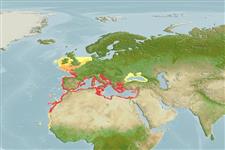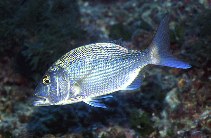Add your observation in Fish Watcher
| Native range | All suitable habitat | Point map | Year 2050 |

|
| This map was computer-generated and has not yet been reviewed. |
| Dentex dentex AquaMaps Data sources: GBIF OBIS |
Upload your photos and videos
Pictures | Videos | Stamps, coins, misc. | Google imageDentex dentex
Picture by Patzner, R.
Pictures | Videos | Stamps, coins, misc. | Google imageDentex dentex
Picture by Patzner, R.
Montenegro country information
Common names:
Zubatac
Occurrence: native
Salinity: marine
Abundance: | Ref:
Importance: | Ref:
Aquaculture: | Ref:
Regulations: | Ref:
Uses: no uses
Comments:
National Checklist:
Country Information: ttps://www.cia.gov/library/publications/the-world-factbook/geos/mj.htm
National Fisheries Authority:
Occurrences: Occurrences Point map
Main Ref: Bauchot, M.-L., 1987
National Database:
Occurrence: native
Salinity: marine
Abundance: | Ref:
Importance: | Ref:
Aquaculture: | Ref:
Regulations: | Ref:
Uses: no uses
Comments:
National Checklist:
Country Information: ttps://www.cia.gov/library/publications/the-world-factbook/geos/mj.htm
National Fisheries Authority:
Occurrences: Occurrences Point map
Main Ref: Bauchot, M.-L., 1987
National Database:
Common names from other countries
Classification / Names Κοινά ονόματα | Συνώνυμα | Catalog of Fishes(Γένος, Είδη) | ITIS | CoL | WoRMS | Cloffa
> Eupercaria/misc (Various families in series Eupercaria) > Sparidae (Porgies)
Etymology: Dentex: Latin, dens, dentis = teeth (Ref. 45335).
More on author: Linnaeus.
Etymology: Dentex: Latin, dens, dentis = teeth (Ref. 45335).
More on author: Linnaeus.
Environment: milieu / climate zone / depth range / distribution range Οικολογία
Θαλασσινό(ά) βενθοπελαγικό; εύρος βάθους 0 - 200 m (Ref. 3688), usually 15 - 50 m (Ref. 54220). Subtropical; 56°N - 12°N, 23°W - 42°E (Ref. 54220)
Κατανομή Χώρες | Περιοχές FAO | Οικοσυστήματα | Παρουσίες | Point map | Εισαγωγές | Faunafri
Eastern Atlantic: British Isles to Cape Blanc, Mauritania; (exceptionally further south) Senegal and around the Canary Islands and Madeira. Common south of 40°N (Spain, North Africa) in the Mediterranean (Ref. 4781).
Length at first maturity / Μέγεθος / Βάρος / Age
Maturity: Lm 34.6 range ? - ? cm
Max length : 100.0 cm TL αρσενικό/απροσδιόριστο; (Ref. 3397); common length : 50.0 cm TL αρσενικό/απροσδιόριστο; (Ref. 3688); μεγ. δημοσιευμένο βάρος: 14.3 kg (Ref. 40637)
Max length : 100.0 cm TL αρσενικό/απροσδιόριστο; (Ref. 3397); common length : 50.0 cm TL αρσενικό/απροσδιόριστο; (Ref. 3688); μεγ. δημοσιευμένο βάρος: 14.3 kg (Ref. 40637)
Short description Κλείδες προσδιορισμού | Μορφολογία | Μορφομετρία
Ραχιαίες άκανθες (συνολικά) : 11; Μαλακές ραχιαίες ακτίνες (συνολικά) : 11 - 12; Εδρικές άκανθες: 3; Μαλακές εδρικές ακτίνες: 7 - 9. Body oval and compressed. Canine teeth, with 4 to 6 anterior teeth very developed in each jaw.
Inhabit hard bottoms (rock or rubble) down to 200 m depth. Usually found in shallow water less than 50 m deep (Ref. 9987). Adults solitary; young gregarious (Ref. 12482). Young fish caught with traps. Feed on fish, mollusks and cephalopods. Important food fish. Marketed fresh or frozen (Ref. 9987). Some attempts to culture this species have been successful. Due to low market supply, the potential for selling these fish from aquaculture operations seems to be good (Ref. 9987). A spear-fisherman cites a specimen caught in Greece (Corfu) with an overnight bottom-line about 1.60 m and 42 kg (Ref. 48271), but the identification cannot be verified.
Life cycle and mating behavior Γεννητική Ωρίμανση | Αναπαραγωγή | Γεννοβολία | Αβγά | Γονιμότητα | Προνύμφες
Gonochoric, but some specimens are hermaphroditic. Species of separated sexes (although some individuals may be hermaphrodite in young stages). In the Mediterranean, reproduction takes place between March and May, in areas near the coast. Embryo development lasts about 3 days at 17°C.
Main reference
Upload your references | Αναφορές | Συντονιστής | Συνεργάτες
Bauchot, M.-L. and J.-C. Hureau, 1990. Sparidae. p. 790-812. In J.C. Quero, J.C. Hureau, C. Karrer, A. Post and L. Saldanha (eds.) Check-list of the fishes of the eastern tropical Atlantic (CLOFETA). JNICT, Lisbon; SEI, Paris; and UNESCO, Paris. Vol. 2. (Ref. 3688)
IUCN Red List Status (Ref. 130435: Version 2024-2)
Ευάλωτο, βλέπε Κόκκινη Λίστα (VU) (A2bd); Date assessed: 17 August 2009
Threat to humans
Harmless
Human uses
αλιεία: Εμπορικό(ά); Υδατοκαλλιέργειες: Εμπορικό(ά); αλιεία αναψυχής: ναί
FAO(Aquaculture systems: Παραγωγή; αλιεία: Παραγωγή, species profile; publication : search) | FIRMS (Stock assessments) | FishSource | Η θάλασσα γύρω μας
Περισσότερες πληροφορίες
Population dynamics
Παράμετροι Αύξησης
Max. ages / sizes
Length-weight rel.
Length-length rel.
Length-frequencies
Mass conversion
Στρατολόγηση
Αφθονία
Παράμετροι Αύξησης
Max. ages / sizes
Length-weight rel.
Length-length rel.
Length-frequencies
Mass conversion
Στρατολόγηση
Αφθονία
Life cycle
Αναπαραγωγή
Γεννητική Ωρίμανση
Γονιμότητα
Γεννοβολία
Spawning aggregations
Αβγά
Egg development
Προνύμφες
Δυναμική προνυμφών
Αναπαραγωγή
Γεννητική Ωρίμανση
Γονιμότητα
Γεννοβολία
Spawning aggregations
Αβγά
Egg development
Προνύμφες
Δυναμική προνυμφών
Anatomy
Επιφάνεια βραγχίων
Brain
Otolith
Επιφάνεια βραγχίων
Brain
Otolith
Physiology
Body composition
Nutrients
Κατανάλωση οξυγόνου
Κολυμβητικός τύπος
Ταχύτητα κολύμβησης
Visual pigments
Fish sound
Diseases & Parasites
Toxicity (LC50s)
Body composition
Nutrients
Κατανάλωση οξυγόνου
Κολυμβητικός τύπος
Ταχύτητα κολύμβησης
Visual pigments
Fish sound
Diseases & Parasites
Toxicity (LC50s)
Genetics
Γενετική
Heterozygosity
Κληρονομικότητα
Γενετική
Heterozygosity
Κληρονομικότητα
Human related
Aquaculture systems
Προφίλ υδατοκαλλιεργειών
Στελέχοι
Ciguatera cases
Stamps, coins, misc.
Aquaculture systems
Προφίλ υδατοκαλλιεργειών
Στελέχοι
Ciguatera cases
Stamps, coins, misc.
Εργαλεία
Bio-Quiz | E-book | Οδηγός πεδίου | Ανάλυση κατά μήκος συνθέσεων | Εργαλείο ιστορίας ζωής | Σημειακός χάρτης | Classification Tree
| Catch-MSY |
Special reports
Download XML
Διαδικτυακές πηγές
Aquatic Commons | BHL | Cloffa | Websites from users | Check FishWatcher | CISTI | Catalog of Fishes(Γένος, Είδη) | DiscoverLife | DORIS | ECOTOX | Faunafri | Fishtrace | GenBank(genome, nucleotide) | GloBI | GOBASE | | Google Books | Google Scholar | Google | IGFA World Record | MitoFish | Εθνικές βάσεις δεδομένων | Otolith Atlas of Taiwan Fishes | Δημόσια ενυδρεία | PubMed | Reef Life Survey | Scirus | SeaLifeBase | Δέντρο Ζωής | Wikipedia(Go, αναζήτηση) | World Records Freshwater Fishing | Zoological Record
Estimates based on models
Preferred temperature (Ref. 115969): 13.3 - 21.1, mean 18.1 (based on 298 cells).
Phylogenetic diversity index (Ref. 82804): PD50 = 0.5001 [Uniqueness, from 0.5 = low to 2.0 = high].
Bayesian length-weight: a=0.01122 (0.00952 - 0.01322), b=3.03 (3.00 - 3.06), in cm Total Length, based on LWR estimates for this species (Ref. 93245).
Τροφικό Επίπεδο (Ref. 69278): 4.5 ±0.4 se; based on diet studies.
Ελαστικότητα (Ref. 120179): Χαμηλό, ελάχιστος χρόνος για διπλασιασμό πληθυσμού 4,5 - 14 έτη (K=0.1; tm=2-3).
Prior r = 0.39, 95% CL = 0.26 - 0.58, Based on 9 data-limited stock assessments.
Fishing Vulnerability (Ref. 59153): High to very high vulnerability (66 of 100).
Climate Vulnerability (Ref. 125649): High vulnerability (63 of 100).




